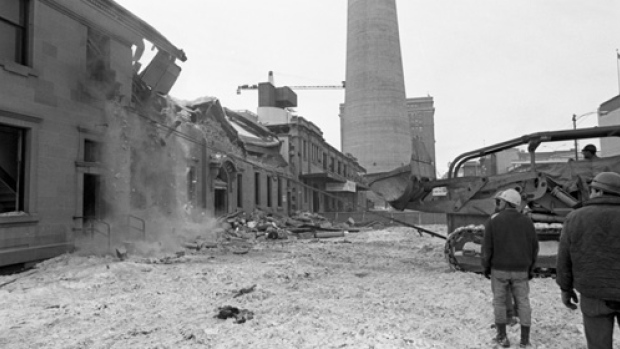The first time I visited Paris, I was a ten-year-old kid on a family vacation.
My mother and my teenage brother, Barry, had read a lot about European history, and they were keen to see the Bastille — the 14th century fortress stormed by revolutionaries in 1789. My brother asked a Paris official for directions, and was shocked to learn that the Bastille had been razed soon after its capture.
Why did Parisians demolish such a landmark? Well, by 1789, the Bastille had been converted into a cruel prison that epitomized despotism. Parisians blotted out a bad memory and replaced it with a plaza that celebrated their revolution.
As in Paris, so in Calgary.
'Good riddance'
The Cecil Hotel was no Bastille, but when the city demolished the 104-year-old east end hostelry last summer, the local consensus was "good riddance."
What had once been a respectable working-class hotel with its own house orchestra, had descended into a nest of crime, drugs, and violence. Its demolition was cheered.
My reaction was the complete opposite. I wanted it saved. To me, heritage preservation is a no-brainer. But I'm in the minority.
To make the case for keeping our old buildings, I have to understand the widespread indifference — if not resistance — to conservation. There is a legitimate debate here. Not every Calgary building can be saved. Not everything should be saved. But exactly what to knock down and what to keep, is not easy to figure out.
Let's start with reasons to fire up the bulldozer.
Fourth rate
There's the argument to be made, that our 'stuff' just isn't worth saving.
'There is no Calgary style of architecture.' - Harry Sanders
Calgary began prosaically as a colonial outpost of a now-vanished empire.
Ultimately, the city established its own identity within a new nation as the regional metropolitan centre of a resource-based economy. Neither Christopher Wren nor Frederick Law Olmsted laid out this city, and we declined to act on Thomas Mawson's urban planning recommendations a century ago.
We have no historic buildings designed by Henry Hobson Richardson or Frank Lloyd Wright, and we tore down our only Francis Rattenbury.
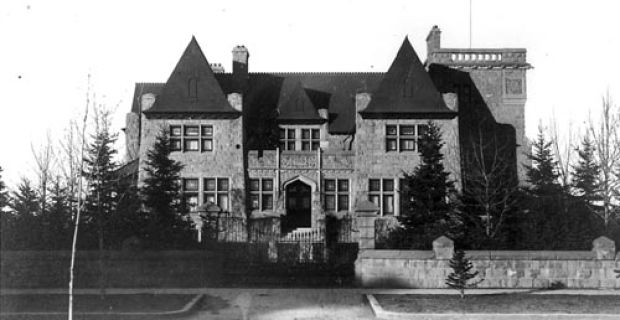
Pat Burn's House c. 1914 designed by Francis Rattenbury. Demolished 1956. (Glenbow Archives)
There is no Calgary style of architecture.
What we have are imitations of building styles that were created somewhere else and executed better there. Further, we have already torn down some of our best structures.
The Southam Building, for example, would have fit right into Gotham City. All that's left are its hundreds of gargoyles, which were cut down from it — and from their context — when the 60-year-old building came down in 1973.
And yet we have saved many inferior structures. Why should we preserve fourth-rate buildings when the first-rate ones are already gone?
Then there's the money issue.
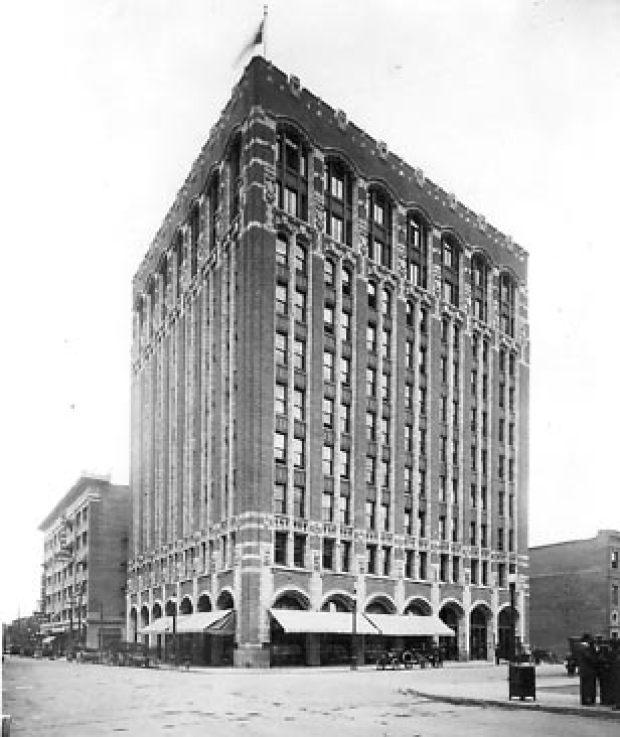
Southam Building at 130 7th Ave. S.W. Seen c. 1913. Demolished 1972. (Glenbow Archives)
Misplaced priorities
In a society with limited resources, every dollar spent on fixing up an old building is one that isn't spent on education, health care, or public infrastructure.
Low-rise heritage buildings occupy valuable real estate that could be used more efficiently and more intensively. And the energy and material required to maintain or upgrade old buildings could be used instead to construct new ones with green standards.
Also, it's not like most of our history was built to last.
Not meant to last
Consider places like the Burns Building, the Lineham Block, and the Lougheed Building — all of them still with us.
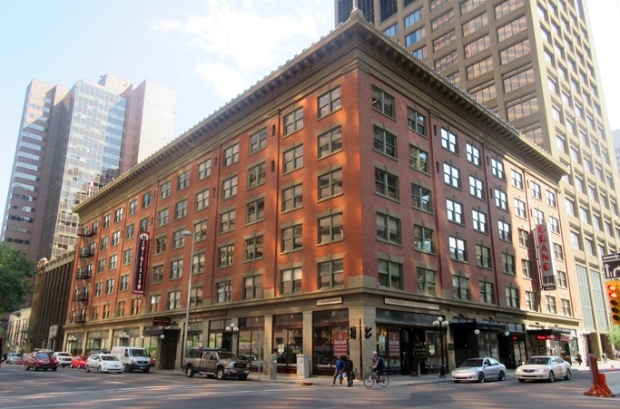
The Lougheed Building at First Street and Sixth Avenue S.W. is now used as office and retail space. (Avison Young)
Their very names remind us of enterprising men who once dominated the city's economy and shaped its skyline and streetscapes. Surely Patrick Burns, John Lineham, and James Lougheed were proud of their magnificent namesake buildings, but they weren't motivated to build future heritage sites as a gift to the ages. They would have torn those structures down themselves if it meant building something more profitable in their place.
There's nothing so holy about commercial buildings, factories, and houses that forces us to preserve them forever.
Our stock of heritage buildings includes corner stores that, although rare in that they survived, were once as plain as today's 7-11. In a journal article I once read, the author asserted that in 50 years' time, an unaltered Wal-Mart store will be a treasured heritage building.
Sometimes, we also need to make room for future treasures.
Need to renew
Calgary is a forward-looking city largely unconcerned with its past. As least apart from the resource development history that gave us the Stampede and the petroleum industry.
Just as newcomers reinvent themselves here, the city reinvents itself time and again. Witness its changing identity as Cowtown, Sandstone City, Stampede City, Host City of the XV Olympic Winter Games, Heart of the New West, and Canada's Cultural Capital.
In Calgary, preservation goes against the grain. Our heritage is to bury our heritage, and be what we will be next. Because sometimes what we were, is worth forgetting.
And, sometimes, we'd rather forget what we were.
Bad memories
In calling for the Cecil Hotel's demolition, the nearby YWCA cited the embitterment of many women's lives at that hotel in its final years. Even after the business closed, the building's very presence was a constant, unwelcome reminder to those who had suffered there.
Similarly, the name of the nearby Langevin Bridge became a source of pain when last year's Truth and Reconciliation Commission report quoted the bridge's namesake, Sir Hector-Louis Langevin, defending the government's residential school policy back in the 1880s.
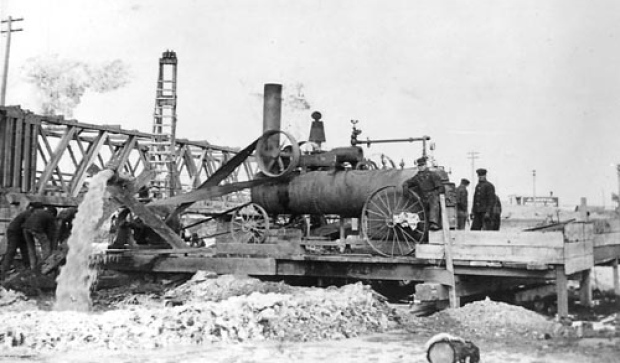
Langevin Bridge under construction in 1910. (Glenbow Archives)
Many Calgarians have voiced a desire to change the bridge's name. Maybe 18th-century Parisians had the right idea — blot out reminders of bad memories and replace them with positive symbols.
The above are all powerful arguments. Yet, there's another side to each.
Counter points
Never mind that our heritage buildings are derivative of better structures far away — they're what we have. Also, just because the original owners of our buildings might have demolished and replaced them, doesn't mean we have to. Heritage value isn't always obvious without the passage of time.
'Calgary's constant change — the knock it down and 'don't look back' attitude — is unhealthy.' - Harry Sanders
As to the 'bad memories' argument... People's strong feelings count for something, and they have to be considered. But the point of history, and of heritage preservation, is not to celebrate the past. We must understand it in toto — for good and for bad.
Yes, the Cecil Hotel fell on hard times, but previous owners had been proud of their business. In the span of a century, it had positive associations along with negative ones. Similarly, some of Calgary's cherished heritage buildings have had their own untoward episodes. That's no reason to get rid of them.
Now when it comes to the 'money' argument, we should remember that existing buildings are just that — existing. They have value.
Every brick, every beam, every floorboard and window has already been manufactured, already been transported, and is already in place. All of the energy, materials, and labour that it took to build that building has already been completed. Demolish it, and you have to start all over again.
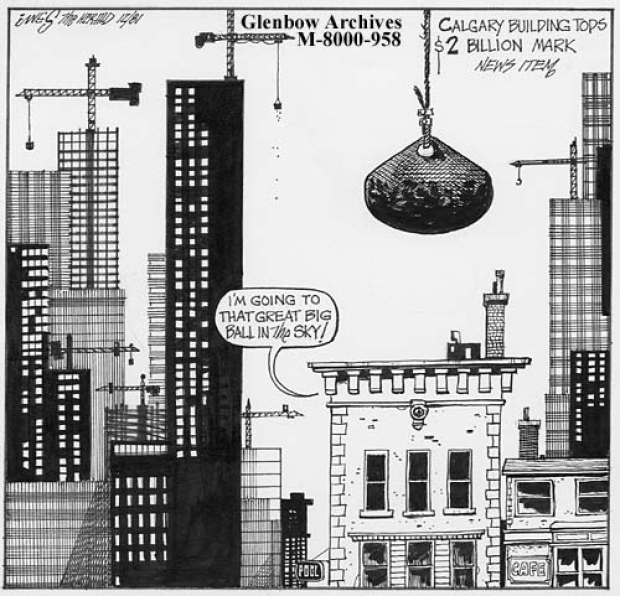
1981 Calgary Herald cartoon by Tom Innes. (Glenbow Archives)
Further, Jane Jacobs pointed out the unique value of old buildings as incubators of start-up local ventures. Without aging, low-rent storefronts, our choices in retail and service outlets could be limited to name-brand franchises.
But overall, and perhaps most importantly, Calgary's constant change — the knock it down and "don't look back" attitude — is unhealthy. It fragments us.
When I encounter historic buildings, I am consciously aware of the shared experience that links us together as a community, as a society, and as part of civilization. Every demolition is a step toward collective amnesia. The loss of each building consigns to oblivion every story and every life that it once contained. If you don't know where you've been, you can't know where you're going.
The balance
'Heritage must contribute something, or it serves only itself. Without function, it is merely form, and we can't afford it.' - Harry Sanders
Call me elitist, but I wouldn't trust the masses to vote on which buildings to keep or whether we should. The majority, no doubt, would prefer tax cuts and shopping malls. I have faith in the theoreticians and policymakers who understand heritage issues and can balance competing interests.
There are broad criteria that city officials use to evaluate a building's worthiness. Yet, at the end of it, what we save needs to have 'meaning'. It must speak to us of our identity. It must be, for want of a better word, significant. If it isn't, give me the keys to the crane and I'll swing the wrecking ball myself.
We can't save all old buildings, nor should we — we'd live in an open-air museum if we did. Neither should we demolish them all. The balance we strike can give us the best of both worlds: A city whose built environment is truly reflective of what it is — and what it has been.

The Calgary Land Titles Office c. 1911 at 7th Avenue and 4th Street S.W. It was demolished in 1970. (Glenbow Archives)
The payoff
Heritage buildings and sites have value beyond their price in dollars and cents. But that value has limits.
Anything we choose to save, must have function and become a paying prospect — or at least offer some kind of value that can be felt or measured.
Sites and buildings can be museums or tourists attractions. Old warehouses can become lofts; old planetariums can become art galleries. And ratty old storefronts can remain just what they are.
Heritage must contribute something, or it serves only itself. Without function, it is merely form, and we can't afford it.
Calgary at a Crossroads is CBC Calgary's special focus on life in our city during the downturn. A look at Calgary's culture, identity and what it means to be Calgarian. Read more stories from the series at Calgary at a Crossroads.

